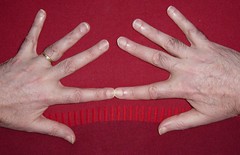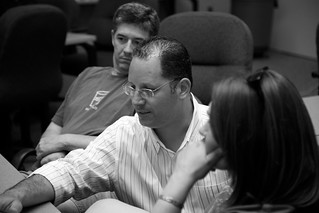Flickring Mind Maps ... making learning sticky
12/01/2006 04:16:00 pmFour ideas came together:
- (1) A month ago, over at The Fischbowl, I read a post called A Math Teacher's Experience about using cell phones to motivate a lesson in mathematics.
- (2) Alan Levine's flickr section of his K12 Online keynote presentation.
- (3) I've been rereading Coming of Age and read Terry Freedman's using flickr as clip art article.
- (4) One of the posts that I have been trying to write and struggling with the words is about the idea that new tools should foster new pedagogies: What can I do now with web 2.0 tools that I couldn't do before?
All my classes are making custom clip art collections ... actually, it's grown into a sort of flickr mind map and review of material that has already been taught. Here's what we're up to ...
Two weeks ago I introduced all my classes to flickr and asked them to sign up for (free) accounts.
Assignment 1 (acclimatisation), Time Frame - one week: Take a picture of your favourite number using your cell phone or digital camera. Upload it to flickr and tag it with a unique tag for each class. Also tag it with the assignment tag: interesting. You cannot copy pictures off the internet but you can "set up the shot" in any way you like. Include a description of why the number you chose is interesting to you. Be creative and have fun with this.
The purpose of this assignment was just to get them used to the mechanics of using flickr. During the week they were working on their first photo assignments I posted this to each of the class blogs (illustrating what success looks like):

This picture shows that 7 x 7 = 49 ... click on it to find out how. ;-)Don't forget about your flickr assignment.
Cheers!
Mr. K.
This was to expose them to the idea of creating "hot spots" on their pictures. As pictures began to come up in public searches on flickr for each of the unique course tags, I created a flickr badge (you'll have to "sign in" to follow that link) for each class. I put it in each blog's sidebar under the heading "Our Math Photo Gallery." The engine behind the badges is the RSS feed associated with each unique course tag. Flickr generates these RSS feeds automatically.
Assignment 2 (concise digital review and content creation), Time Frame - one week: We're about halfway through the semester. Each class was given a topic or unit we had studied together; Pre-Cal 30S: quadratic functions; Pre-Cal 40S: trigonometry; AP Calculus AB: derivatives. They have to take a picture of something in the real world that is connected to these ideas. The picture can be "set up", but it has to be a real photograph taken by the students themselves. Screen shots and pictures of something written down don't count ... it has to be a "real world" picture. Once they have taken and uploaded the picture they have to fill in as many hot spots on the picture as they can illustrating concepts related to the topic they were given.
The Goals: They will have at least two more assignments like this last one ...
- »They are learning to look at the world through mathematical eyes and see the math in everything, everywhere. Those with cell phone cameras are walking around thinking about and looking for math everywhere they go.
- »In the course of looking for the pictures and creating the annotated hot spots they will be thinking about the material covered in a new way and strengthening the mental links to the concepts they have learned. I hope to make their learning sticky.
- »They are creating digital mind maps of the material we learned way back at the beginning of the semester. Each student contributes one to the pool. At exam time they can review all the annotated pictures in the pool made by themselves and their classmates. They will be teaching and learning from each other.
- »They are creating a course specific set of real world "clip art." They can use the pictures in projects, assignments and blog posts. I will also be able to use them the next time I teach the course to benefit the next group of students. They will be teaching people they have never met. They are also building a permanent resource collection.
- »They are having fun with this. So am I watching it unfold. They are talking to other students and teachers in the building about this. A buzz is growing. Can you imagine the conversations they are having at home? They are involving their families and friends in their learning.
Some Snags
There were two snags.
First, most kids just uploaded a single picture to flickr. It didn't show up in the tag search. When a new account is created on flickr a real live human being examines the pictures in the account to ensure that they are real photos and not clip art, screen captures, etc. If they are real pictures, the public photos in the account are added to the pool of pictures in flickr searches and RSS feeds. However, there must be a minimum of 5 public pictures in the account in order to start this review process.
Second, they found my flickr account and saw pictures of me. I had told them to never upload pictures of themselves to the internet. When they saw that I have pictures of myself online a couple of them figured it would be alright to upload pictures of themselves as well. (That really drove home a lesson to me about modeling.) In some cases, the inclusion of pictures of themselves was an honest oversight. We discussed the fact that teachers and students are different. I also explained how I came to have pictures of myself online: the photos are used in publications or conference announcements that I am a part of; they are part of my professional life. In our student-teacher relationship I am very careful to protect their identities. As we have discussed in class many times, their anonymity as students is important. We do not do anything that connects their images to their names. This was an important lesson for them (and me). Because of the school division's proxy server filter we cannot do this sort of assignment at school. In a computer lab I can monitor my students closely. We could have addressed this issue when it came up immediately. If the school division didn't have a filter this project could have started more safely. All students that had uploaded pictures of themselves have removed them. We are only taking pictures of things, not people. If a picture is of a person, their face is obscured. Most students are using aliases as their flickr user names, others are using first names only.
Assessment
A very close, granular assessment of this sort of assignment would undermine the pedagogical goals. I expect a lot of deep learning to come out of this. This assignment is being marked for completion only; if it's done they get 100%, if not they get 0%. In thinking about using new tools effectively I also do not want to make mine or my students workload heavier. I characterize this as assessment for learning. This includes the time and effort required for assessment. The badge on each class blog picks up the pictures as they are uploaded. Also, a quick search in flickr, by course tags (pc30sf06, pc40sf06, apcalc06), brings up all the related students work instantly. Marking is a breeze.
The Results
The "real" assignments (the mind maps) are due on Monday, December 4. The Pre-Cal 30S class assignments are due on Wednesday, December 6 (they have a large project due on Monday). I'm looking forward to seeing what they come up with.
Check out the flickr badges in the side bar of each class blog:
Pre-Cal 30S (Fall '06)
Pre-Cal 40S (Fall '06)
AP Calculus AB (2006-07)
I couldn't do any of this before RSS, tagging, linking and of course, flickr. ;-)



7 comments
Devil's advocate time: "Why are teachers and students different?"
ReplyDeleteThe difference is that between a child and an adult.
ReplyDeleteMy decision to put my picture online was not made quickly or easily. I would expect them to learn to carefully consider the consequences of publishing their identities. This is one of the things that I discuss with all my students at the beginning of each semester.
Also, the policy in our school division is to never publish a picture of a student that also has their name attached to it. When working with my students online I am careful to abide by this policy.
I know that my administration reads my blog. Other administrators from my school division also read this blog. I have always been transparent about what I'm doing in the classroom and the steps I have taken to ensure my students safety.
I was going to blog about this activity a week ago, but decided to wait to see how things unfolded on flickr first so that I could address any "issues" that arose before I made public what my students were up to. I feel that the conversations we had in class were important ones and my students have learned a lot about safe and ethical online behaviour as a result.
There's a directory of mind maps at http://www.topicscape.com/mindmaps/
ReplyDeleteIt has hundreds of mind maps categorized by subject, with thumbnails and links to the original.
I don't mean to criticize your project Darren at all. I think it is phenomonally creative and the results speak for themselves.
ReplyDeleteI also know and understand the need to respect school polcies. I believe that our literacies are becoming based as much on images as they are on text. Requiring kids to see the math in the world is an excellent example of that. Please don't see my comment as criticism. I only wonder sometimes if, as teachers, we set too large of a wall between our students are ourselves.
anonymous: Thanks for the link to the mind maps ... I'll have to explore that. ;-)
ReplyDeleteClarence: I didn't think you were being critical of the assignment. I am more anxious about this assignment than any other online work I have done with my students because it could so easily become an "issue" vis a vis the school division policy I mentioned above.
There was a time when no one in my school division knew or cared about what I write here. That has changed; I am more and more aware of the diversity of my "audience."
No insult was taken. Please believe me that none was intended as well. ;-)
While I know what you mean about the "walls between teachers and students," in this case, there is a difference. But that difference doesn't have to be a wall. ;-)
Can't wait to try this with my classes! Thanks for the inspiration and the tips (and snags).
ReplyDeleteInspiration passed on...
ReplyDeletehttp://virtualsouthside.ning.com/profiles/blogs/using-flickr-to-connect-math
Thanks much,
Sean